Editor’s Note: In October 1954, when Queen Elizabeth II was just 28 years old, Reader’s Digest gained an eyewitness account of the world’s most influential royal. We’ve chosen to republish this excerpt from the original full-length article, due to the enduring interest in the British royal family.
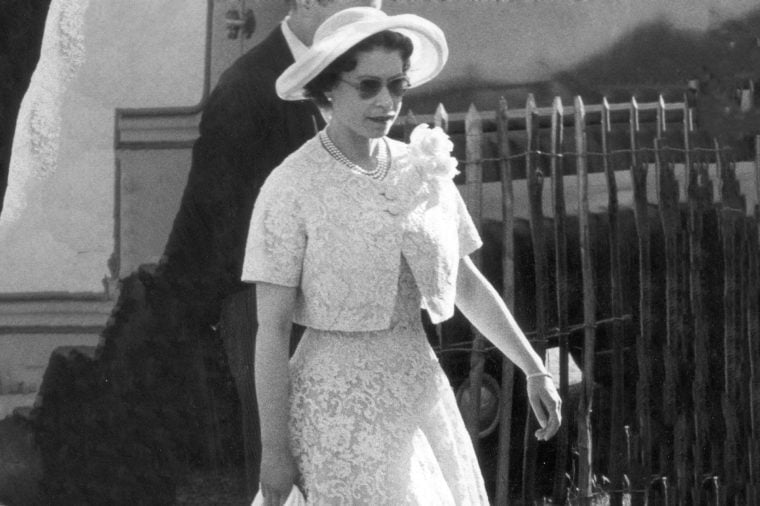 On the morning of Thursday, May 13, 1954, an RAF patrol plane, 200 miles from land, sighted a small black ship, spanking along as though in an exceptional hurry. She showed a mustard-colored smokestack, a white superstructure, and her raked bow pointed toward England. One look sufficed. The fliers broke into cheers, tossed caps around, and swooped down to salute the little vessel at deck level. Luck had selected them to be the first of millions of impatient Britons to welcome the royal yacht Britannia, bearing home Queen Elizabeth II after a six-month tour around her realm; their enthusiasm gave only a rough idea of what was waiting for Her Majesty at journey’s end. (These are 11 things Queen Elizabeth always takes when traveling.)
On the morning of Thursday, May 13, 1954, an RAF patrol plane, 200 miles from land, sighted a small black ship, spanking along as though in an exceptional hurry. She showed a mustard-colored smokestack, a white superstructure, and her raked bow pointed toward England. One look sufficed. The fliers broke into cheers, tossed caps around, and swooped down to salute the little vessel at deck level. Luck had selected them to be the first of millions of impatient Britons to welcome the royal yacht Britannia, bearing home Queen Elizabeth II after a six-month tour around her realm; their enthusiasm gave only a rough idea of what was waiting for Her Majesty at journey’s end. (These are 11 things Queen Elizabeth always takes when traveling.)
Elizabeth, acknowledging the RAF salute with a wave, was unaware that she was heading into a homecoming demonstration unprecedented in British history—an all-out people’s welcome, spontaneous, unrehearsed, tumultuous. She knew only that the Home Fleet waited to greet her at Plymouth in the morning and that her 50,000 miles of traveling would end on Saturday when she arrived in London and drove home in the ceremonial coach. It looked much like the usual routines prescribed for royal returns long centuries ago.
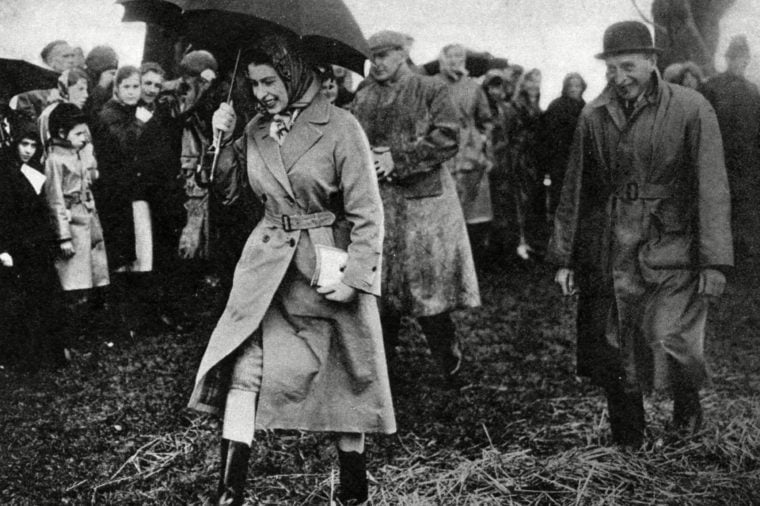 This was one time, however, that the British people jumped the gun on routines. Instead of waiting conventionally to wave from London’s sidewalks, they suddenly cast tradition to the winds. They crowded into trains and buses and headed hilariously for the south coast. Even the British weather began going crazy. It forgot to rain. Larks sang. Lambs frolicked. The countryside shimmered in buttercups and daisies, primroses, bluebells, in spring tapestries.
This was one time, however, that the British people jumped the gun on routines. Instead of waiting conventionally to wave from London’s sidewalks, they suddenly cast tradition to the winds. They crowded into trains and buses and headed hilariously for the south coast. Even the British weather began going crazy. It forgot to rain. Larks sang. Lambs frolicked. The countryside shimmered in buttercups and daisies, primroses, bluebells, in spring tapestries.
By Thursday morning, roads groaned under a load of traffic unsurpassed since D-Day—cars, trucks, scooters, cycles, carts—all hurrying to the shore. Over footpaths and byways came hikers with knapsacks. Each hour, trains disgorged more and more thousands at coastal key points. Ports and small villages wore the resplendent air of momentarily awaiting the royal presence in the high street. From a thatched roof, perched over Mevagissey Harbour, flew a starched bed sheet, embroidered in red-and-blue cardboard letters. It read: “God Bless You, Dear!”
By noon, old folks and young, babies, even dogs, were massing on the cliffs. Repasts, spread over endless bluffs and headlands, uncovered an added reason for high spirits. The last of Britain’s food controls were ending. Out of brown paper bags and baskets cascaded sandwiches, spread with real butter, filled with actual meat; oranges, bananas, sugar cookies, candies, nuts. Like other achievements in the Queen’s brief reign—the Conquest of Everest, the Four-Minute-Mile, the British-Australian Cricket Trophy—the end of 14 years of rationing confirmed the mass belief that, in this second young Elizabeth, Old England had once more hitched her wagon to a star.
Content continues below ad
The sun sank. The long twilight waned. The wind rose. But still, the people waited.
The next day the multitudes camped on Rame Head were rewarded with a thrilling spectacle. The weather was now cryptically described as “Fair, with bright intervals.” Shortly before 9 a.m., the gray curtains shrouding Plymouth to the east parted as though snatched back by a giant hand. Through the opening appeared the dramatic silhouette of the Home Fleet, 17 ships of the line, dressed over-all and headed by Vanguard, Britain’s mightiest battleship. Behind Vanguard, deployed in three faultless columns, came carriers, cruisers, destroyers, frigates—a procession 3.5 miles long and 2 miles wide. The next moment gray curtains lifted in the west. Through them entered the royal yacht, escorted by destroyers. On the saluting bridge stood England’s queen and her tall sailor husband. (Check out these 16 rarely seen photos of Queen Elizabeth and Prince Philip.)
The flotillas approached each other majestically, gray shapes shearing gray waters, spray flying over long Atlantic swells. Then, abruptly, a hoist of signals snapped at Vanguard’s yardarm. The guns of the entire Home Fleet thundered in unison. The 21-gun royal salute crashed over the Devon hilltops, reverberating around the world by radio pickup. Britannia knifed on ruler-straight between the cheers, the gun smoke, the avenue of passing warships. Then came another signal: “Execute!” With the precision of a drill, the Home Fleet reversed course in a superb maneuver, maintaining exact station, two columns describing a semicircle to starboard, the third a corresponding swing to port. Great silver-snouted helicopters, the Royal Navy’s “hover birds,” carried the measure into the third dimension.
It was now decently in order for the Home Fleet, spread out behind Britannia like a bridal veil, to get on with the business of escorting her to the Isle of Wight.
“Your Majesty, with humble duty!” invited the flagship. Britannia accepted with pleasure and becoming surprise.
“A wonderful moment!” Britannia signaled back.
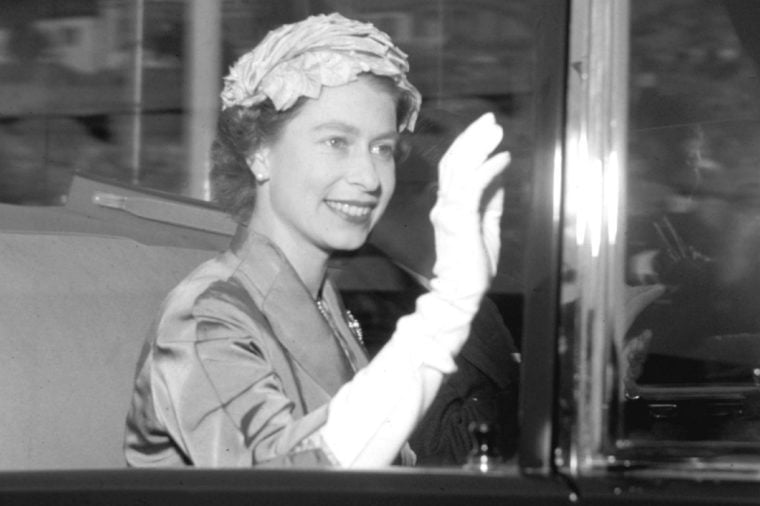 By the queen’s wish, the 100-mile voyage was accomplished “as close inshore as is compatible with safety.” As a result, unnumbered millions of the self-appointed welcoming body obtained a view of the procession. In and out of fog, haze, squalls, and showers led the royal route. Contact, shore-to-ship, however, remained unbroken. It was sustained by bands, church bells, cannon, loudspeakers, telescopes, and an armada of intrepid small craft.
By the queen’s wish, the 100-mile voyage was accomplished “as close inshore as is compatible with safety.” As a result, unnumbered millions of the self-appointed welcoming body obtained a view of the procession. In and out of fog, haze, squalls, and showers led the royal route. Contact, shore-to-ship, however, remained unbroken. It was sustained by bands, church bells, cannon, loudspeakers, telescopes, and an armada of intrepid small craft.
The whole south coast had become one tremendous grandstand. The welcome built up to an uproarious pitch that a stranger might have thought overdone, almost hysterical. But a stranger could not have known the deep emotions that stirred the British on this day. They were not only welcoming home their hardworking young Queen. They were celebrating the success of a desperate struggle out of bankruptcy, showing the world a new and vital England risen from the ruin of war.
To Elizabeth, it was the finest homecoming gift in the world. Signals pouring into the yacht told her that production had reached an all-time high in British history, almost 50 percent above prewar. Gold and dollars were rushing into London to buy British stocks and bonds. Interest and sinking fund on the U.S. loan were fully paid. Steel, electricity, food outputs were all making records, exports were up 6 percent since 1953, wages 3 percent. Above all, the pound sterling, the infallible barometer of Britain’s rags or riches, had doubled in value, shortly would become a free exchange. To her the figures were anything but dull. (These are the laws Queen Elizabeth doesn’t need to follow.)
Content continues below ad
As the yacht steamed on, an incident underlined one of the reasons for Elizabeth’s popularity. In a bank of mist, the three-man crew of the fishing trawler Endeavour suddenly beheld the yacht looming almost above them. A young fisherman named Terry Akers rushed to the mast, dipped their red ensign in salute. Then he whipped off his cap and froze to attention beside his jerseyed shipmates. Gravely, the Queen gave an order, and the huge white ensign on Britannia dipped in acknowledgment as ceremoniously as if replying to an ocean liner. It was no grandstand play. No one ashore could even see it. It was simply that, to the queen, three fishermen earning their living from the sea were as important as the highest in the land. It is for count less such actions, coming from the heart, that Elizabeth’s people love her.
The Solent, the narrow channel between the mainland and the Isle of Wight, from which was launched most of the D-Day strike, offered the shorebound the first chance for a close-up. To safeguard vantage spots, many had camped overnight in cars, tents, even haystacks, for here it was that the Home Fleet would take leave of the queen with another dramatic maneuver—a high-speed mass convergence on Britannia, a precision turnoff at 1OO yards and a final sweep-past, all hands standing by to cheer.
But no sooner did the coast-guard lookout sight Britannia than the scene at the Solent turned to pandemonium, a three-ring circus covering air, sea, land. Without warning, aircraft of all description darted into the overcast: private, chartered, single and multi-engined—diving and churning, no two flying in the same direction. Now RAF flying boats battled to clear a path for an oncoming jet salute. The 60 navy jets streaked through the melee like comets, emerging miraculously in the clear. On the water things were in an equal turmoil. Small craft which had been decently restrained all day now suddenly up-anchored, escaping in all directions—yachts, trawlers, tenders, tugs, excursion steamers, dinghies, dories. They cut loose with a disregard for danger unequaled since Dunkirk. Driven by sail and power, they ducked inside warship screens, disappeared in wakes, popped up again like corks, waved arms, oars, lifebelts, rushing Britannia from every angle. Commands blinked from warships: “Little Ships Move Over!” and “Keep Off!”
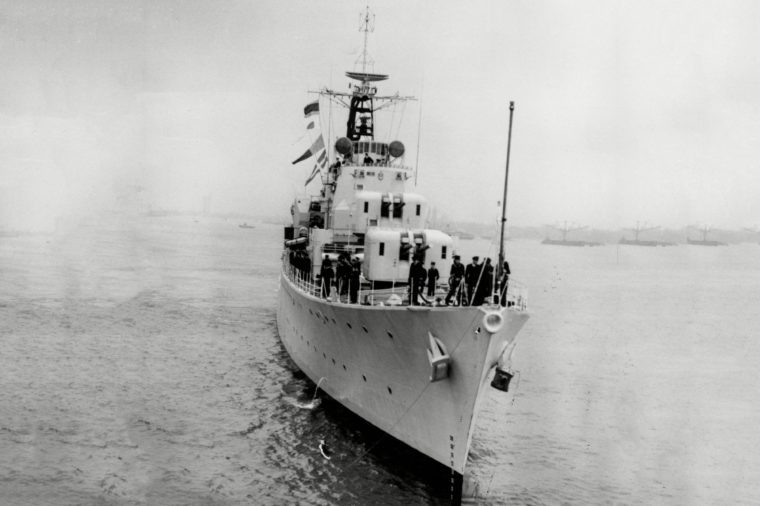 The destroyer Duchess finally saved the day. Breaking escort, she improvised a zigzag dance before the royal yacht, barking out paralyzing threats through her loudspeakers. She cleared a path just wide enough for the Home Fleet’s final ritual, another masterpiece of seamanship. The 17 great ships tore by, crews lining rails, caps lifting in a single motion, Vanguard’s band playing “God Save the Queen.” As the queen smiled and waved, the Home Fleet headed once more to sea.
The destroyer Duchess finally saved the day. Breaking escort, she improvised a zigzag dance before the royal yacht, barking out paralyzing threats through her loudspeakers. She cleared a path just wide enough for the Home Fleet’s final ritual, another masterpiece of seamanship. The 17 great ships tore by, crews lining rails, caps lifting in a single motion, Vanguard’s band playing “God Save the Queen.” As the queen smiled and waved, the Home Fleet headed once more to sea.
Britannia was nearing Portsmouth when, from nowhere, appeared a long green barge, cleaving the scummy water. It passed unchallenged through warship screens and aimed directly for the royal yacht. In the cockpit sat a venerable figure, wearing a baggy reefer jacket, a jaunty cap and chewing a long cigar.
Content continues below ad
A lot of thoughts had turned to him that day. The sight of concrete tank traps, still barricading the shore, had stirred up memories of a less happy occasion in British history, of a beleaguered island confronting an overwhelming foe. Thousands had caught again an echo of words which had inspired everybody’s courage, had cast out doubt and dared the enemy to cross this very strip of water: “We shall fight on the beaches … on the landing grounds … in the fields and in the streets … in the hills. We shall never surrender.”
Britannia‘s engines slowed. She lowered her starboard gangway, reserved exclusively for royalty. Amid bedlam, the valiant old warrior pitched his cigar away and climbed aboard. By unprecedented honor, Sir Winston Churchill, first servant of the realm, accompanied his queen the last stretch of her triumphant journey home.
By midnight, thousands were reenacting south-coast picnic scenes on London’s rainy parapets and pavements, determined to see the queen next day from a front row. Old and young reclined, squatted, huddled, supervised by fatherly policemen. Many were veterans of curbside overnighting, experts at insulating bodies with wads of newspaper (next day, 16 tons were picked up near Buckingham Palace alone), at defending home base while whisking children to the nearest lavatory. Rain, driven by east winds, came down in cloudbursts. The crowds bailed this pneumonia setup as a happy omen. “The Queen’s weather—not ‘arf!” they said proudly. “She’ll know she’s ‘ome again!” (It rained on Elizabeth’s wedding day, on her first ceremonial appearance after accession, at her coronation, and when she departed on her tour.)
By morning it let up. Gray skies looked down over business areas as deserted as an evacuated city. “Closed for the Day!” read signs in hundreds of windows. High over the crowds that lined the route to Buckingham Palace appeared 30-foot standards, crowned with lions and unicorns, supporting decorative shields which commemorated the different areas of Her Majesty’s tour. They symbolized the British Commonwealth of Nations, 600 million people, one quarter of the world’s population, united under one flag. Down on the exposed embankment on (where, at 3:30 p.m., the queen would land) and on Westminster Bridge, which overlooks it, winds lashed the shivering crowds in gusts of 40 mph.
While London waited, Britannia made her way around the cliffs of Dover and into the Thames estuary. Today marked the fist time that any sovereign had reentered the kingdom by the gloomy old waterway that had helped to build an empire. River traffic was at a standstill, and the 50-mile tideway presented an unforgettable panorama. The Thames “home fleet,” grubby hulls spectacularly “dressed,” was lined up two and three deep—coasters, canal barges, tugs, tankers, the stubby freighters that haul in raw materials from the Seven Seas and hustle out finished products.
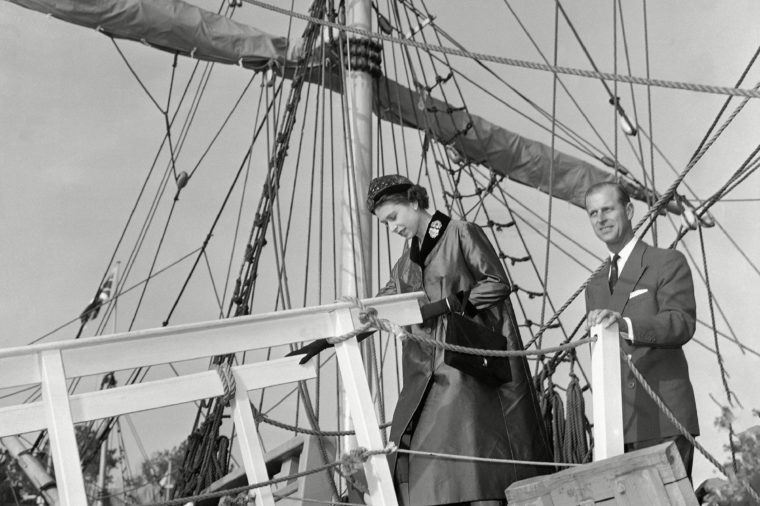 Britannia sailed gravely between avenues of dipping jib arms, wharf cranes, salutes from warehouse hooters and ships’ sirens and cheering carpets of humanity. She sailed past sites and scenes woven into British history—the old Fort at Tilbury where Elizabeth I had defied the oncoming Spaniards (“I have the body of a weak and feeble woman, but I have the heart and stomach of a King and a King of England, too!”), past Deptford Reach, where, nearly four centuries before, Francis Drake anchored his galleon The Golden Hind after her voyage around an almost unknown world, where he knelt on her weathered deck to receive his knighthood.
Britannia sailed gravely between avenues of dipping jib arms, wharf cranes, salutes from warehouse hooters and ships’ sirens and cheering carpets of humanity. She sailed past sites and scenes woven into British history—the old Fort at Tilbury where Elizabeth I had defied the oncoming Spaniards (“I have the body of a weak and feeble woman, but I have the heart and stomach of a King and a King of England, too!”), past Deptford Reach, where, nearly four centuries before, Francis Drake anchored his galleon The Golden Hind after her voyage around an almost unknown world, where he knelt on her weathered deck to receive his knighthood.
Content continues below ad
Now appeared a barge, slowly and ceremoniously rowed. In the stern, attired in black and gold robes of office, stood the Lord Mayor of London. He doffed a medieval cocked hat and bowed. In words well-chosen many centuries before, speaking for the “free men” of London, he granted formal permission to the Sovereign to pass into the city. The great bascules of Tower Bridge swung open wide. Britannia passed slowly between the rugged buttresses and dropped anchor in the Pool of London.
Back on the embankment, the 41-gun salute fired by the Tower batteries stirred up fresh paroxysms of excitement. Westminster Bridge, spanned by a solid arch of faces, cheered and let fly with jubilant renditions of “The Bells Are Ringing for Me and My Gal!” A detachment of naval ratings, immaculately pipe-clayed, marched onto the embankment. The Grenadier Guards arrived, red coats, busbies, white gloves, preceded by a stirring brass band. They formed themselves into a Guard of Honour. Up clattered the Household Cavalry, plumes waving, breastplates gleaming, black horses set off by saddle pads of snowy bearskin. Personages began to arrive—the Archbishop of Canterbury, lords and their ladies, gold-braided officers ablaze with medals.
And now, around the bend from Whitehall, appeared a Cinderella picture—outriders in scarlet, a royal coach drawn by matched grays, ridden by white-wigged postilions in blue and gold. At 3 p.m. appeared the prime minister, who had disembarked from Britannia down the river. In silk hat and frock coat, he was waiting to welcome his Sovereign as ritual prescribed.
A few more minutes and there began a roar, generated by a million human lungs and reinforced by gunfire, bands, horns, hooters, sirens, and a last frenzied chorus of “The Bells Are Ringing” from the bridge.
Next, learn little-known facts and scandals about Queen Elizabeth II.
The post This Is What It Was Really Like to See Queen Elizabeth in the 1950s appeared first on Reader's Digest.
from Reader's Digest https://ift.tt/2s10JFn
ليست هناك تعليقات:
إرسال تعليق